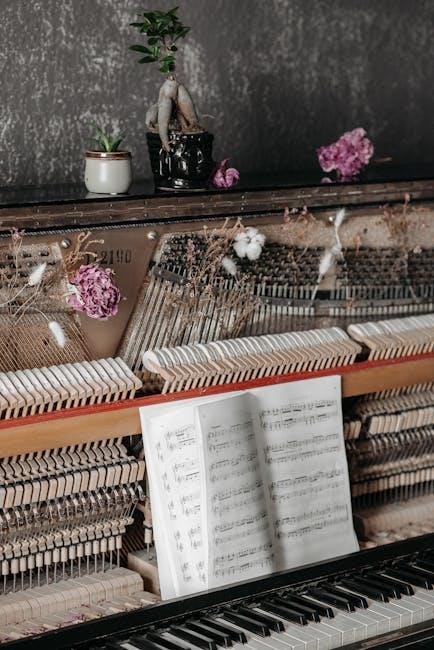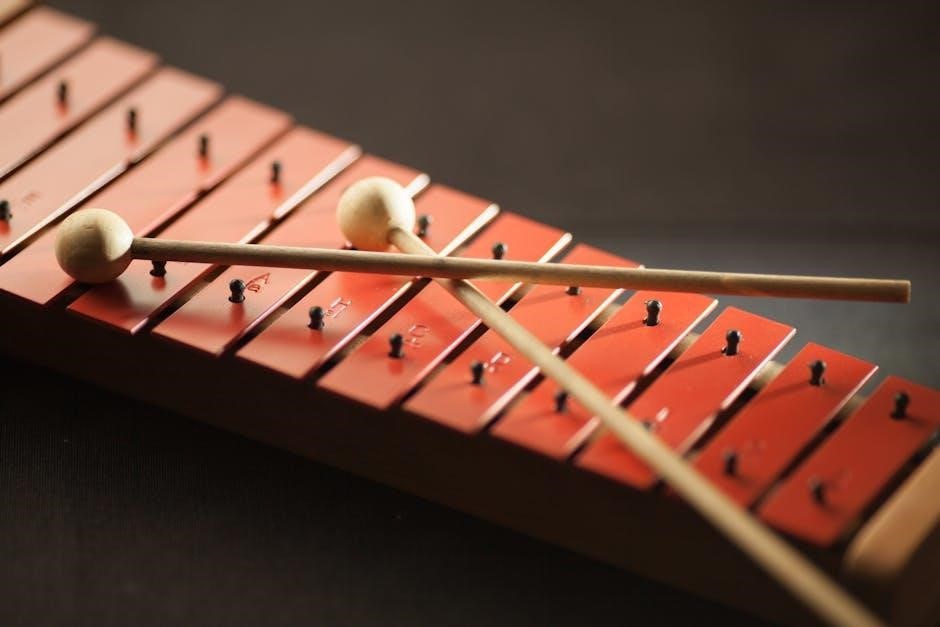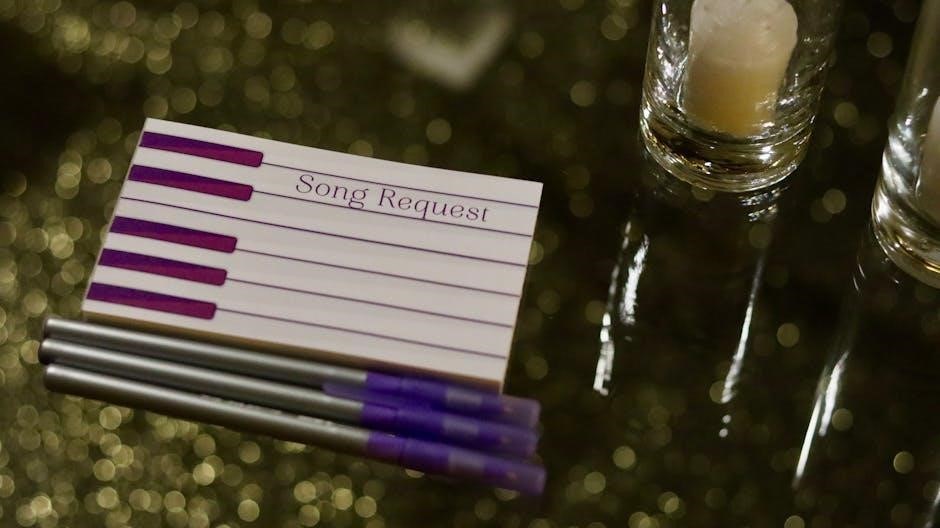music notes flash cards pdf

music notes flash cards pdf
Music note flash cards are essential educational tools for musicians, helping students and educators alike to quickly recognize musical notes and symbols. These cards, often available as downloadable PDFs, provide a practical and interactive way to master music notation, covering both Treble and Bass clefs. They are designed to be printed and used for effective music learning, making them a valuable resource for anyone seeking to improve their musical skills.
1.1 Importance of Music Note Flash Cards in Learning
Music note flash cards are invaluable for building a strong foundation in music literacy. They simplify the process of memorizing musical notation, enabling learners to quickly recognize notes and symbols. By using flash cards, students can improve their sight-reading skills, enhance note recognition speed, and develop a deeper understanding of music theory. These tools are particularly beneficial for beginners, as they make complex concepts more accessible and engaging. Regular practice with flash cards fosters confidence and fluency in reading music, making them an essential resource for both classroom and self-directed learning environments.
1.2 Overview of Music Note Flash Cards PDF
Music note flash cards PDFs are downloadable resources designed to aid in learning musical notation. These files typically include sets of cards featuring notes on the Treble and Bass clefs, along with symbols and note values. Many PDFs are free to download and print, offering a convenient way to create physical flash cards. They are organized for easy use, often laminated for durability, and provide a portable tool for practice. These PDFs cater to learners of all levels, from beginners to advanced musicians, making them a versatile and practical study aid for music education.

Benefits of Using Music Note Flash Cards
Music note flash cards enhance learning by boosting note recognition, improving sight-reading, and making practice engaging. They offer a portable, versatile tool for musicians of all levels to master musical notation effectively.
2.1 Improving Sight-Reading Skills
Music note flash cards are invaluable for enhancing sight-reading abilities. By regularly practicing with these cards, musicians can quickly identify notes on both the Treble and Bass clefs. This rapid recognition builds confidence and fluency in reading sheet music, allowing performers to focus on expression and technique during practice or performances. The portability of flash cards makes them ideal for daily practice, ensuring consistent improvement in sight-reading skills over time.
2.2 Enhancing Note Recognition Speed
Music note flash cards significantly boost note recognition speed by providing repetitive and focused practice. Each card presents a note or symbol, allowing learners to quickly associate visual cues with note names. This repetition strengthens memory and reflexes, enabling faster identification during performances or lessons. The structured format of flash cards ensures comprehensive coverage of both Treble and Bass clefs, making them an effective tool for musicians aiming to enhance their note recognition abilities efficiently.
2.3 Making Learning Interactive and Engaging
Music note flash cards transform learning into an interactive and engaging experience. By using physical cards, students can participate in quizzes, memory games, and group activities, making the process enjoyable. The hands-on approach allows learners to actively identify notes, fostering a deeper connection with musical notation. These cards also encourage friendly competitions and collaborative learning, creating a dynamic environment that motivates students to practice regularly. Their portability and ease of use make them ideal for both individual study and classroom settings, ensuring an engaging experience for all skill levels.

Structure of Music Note Flash Cards
Music note flash cards typically include notes on the Treble and Bass clefs, along with common note values and musical symbols, aiding in comprehensive music notation learning.
3.1 Treble Clef Notes
Treble clef notes are foundational for many musicians, particularly pianists and vocalists. Flash cards featuring these notes often display the note name on one side and its position on the staff on the other. This design helps learners quickly associate names like A, B, and C with their placements. Many PDFs include colorful, laminated cards for durability, making them ideal for both classroom use and individual practice. They are a key tool for building sight-reading skills and musical literacy.
3.2 Bass Clef Notes
Bass clef notes are crucial for musicians, especially those playing lower-pitched instruments like cellos or trombones. Flash cards often feature the note name on one side and the musical symbol on the other, aiding quick recognition. Many PDFs include colorful, laminated cards for durability, suitable for classroom or individual use. These tools are excellent for building proficiency in reading bass clef notation, essential for orchestral and ensemble musicians. They help learners master note positions and symbols efficiently.
3.3 Note Values and Symbols
Music note flash cards often include sections dedicated to note values and symbols, essential for understanding rhythm and notation. These cards typically feature visual representations of whole, half, quarter, and eighth notes, along with rests and other musical symbols. PDF resources provide clear, printable designs, making it easy for learners to practice recognizing and interpreting these elements. Flash cards help students grasp the relationship between note durations and musical expressions, enhancing their ability to read and perform music accurately.

How to Create Music Note Flash Cards
Design effective flash cards using software like Canva or Google Docs. Include note names, symbols, and clefs on one side with corresponding notation on the other. Print on cardstock, laminate for durability, and organize by difficulty for structured learning.
4.1 Designing Effective Flash Cards
When designing music note flash cards, prioritize clarity and simplicity. Use large, easy-to-read fonts for note names and symbols. Include both Treble and Bass clefs, ensuring each note is clearly displayed. Add corresponding keyboard diagrams or staff visuals for better association. Use contrasting colors to differentiate fronts and backs. Organize cards by difficulty, starting with basic notes and progressing to more complex symbols. Ensure each card is visually consistent to aid quick recognition. Include spaces for students to write notes or practice identification exercises.
4.2 Printing and Laminating Tips
For durable and long-lasting music note flash cards, print your PDF on high-quality cardstock or thick paper. Use a duplex printer to print on both sides, ensuring notes and answers are clearly visible. After printing, laminate the cards using thermal laminating sheets for protection against wear and tear. Cut the cards neatly, leaving a small border for strength. Consider rounding the corners for easier handling. Store the laminated cards in a protective binder or pouch to keep them organized and extend their lifespan.

Tips for Using Music Note Flash Cards
Use flash cards regularly for effective practice. Shuffle cards to avoid memorization patterns. Track progress to identify areas needing improvement. Incorporate interactive activities for engagement and retention. Set goals for daily practice to build consistency and confidence in note recognition skills.
5.1 Study Techniques for Maximum Retention
Effective study techniques with music note flash cards involve regular practice and active engagement. Shuffle cards frequently to avoid pattern memorization. Use the front for note names and the back for verification. Test yourself by covering answers and gradually increasing speed. Incorporate games like “Note Races” or team challenges for interactive learning. Set specific goals, such as mastering a set of notes weekly. Track progress to identify and focus on challenging areas. Consistency and variety in study routines enhance retention and build confidence in note recognition.
5.2 Incorporating Flash Cards into Music Lessons
Incorporating music note flash cards into lessons enhances engagement and reinforces learning. Teachers can use them as quick drills, memory games, or interactive activities. Display a card and ask students to identify the note or symbol, fostering immediate feedback. Group activities, such as races to name notes, add fun competition. Flash cards can also be paired with practical exercises, connecting theory to application. This integrated approach ensures students retain information and apply it confidently during performances or practice sessions, making lessons dynamic and effective.

Popular Music Note Flash Cards PDF Resources
Popular resources include free downloadable templates from websites like The FJH Music Company and LessonFace, offering printable PDFs for Treble and Bass clef notes, ideal for music education.
6.1 Free Downloadable Templates
Free downloadable templates for music note flash cards are widely available online, offering pre-designed layouts for both Treble and Bass clef notes. Websites like The FJH Music Company and LessonFace provide PDFs that are easy to print and laminate. These templates often include standard and stick notation, making them versatile for various learning styles. They cater to different skill levels, from beginners to advanced learners, and are ideal for classroom use or private music lessons. Users can customize some templates to suit specific needs, ensuring effective and engaging music education.
6.2 Recommended Websites for Music Flash Cards
Top websites for music flash cards include The FJH Music Company, offering comprehensive PDF sets, and LessonFace, providing sample flash cards for note recognition. Canva and other platforms offer customizable templates for music education. These sites provide free and paid resources, catering to various skill levels. They are ideal for educators and learners seeking high-quality, printable materials to enhance music literacy. These websites are trusted sources for effective and engaging music flash cards in PDF format.

Alternatives to Physical Flash Cards
Digital flash card apps like Anki and Quizlet offer interactive music note practice. Online tools provide games and exercises for engaging learning. Perfect for modern students.
7.1 Digital Flash Card Apps
Digital flash card apps like Anki and Quizlet revolutionize music note learning. These apps allow users to create or download decks of music note flash cards, enabling anytime, anywhere practice. Features include spaced repetition, audio support, and interactive exercises. They are ideal for students and educators seeking a modern, efficient way to master musical notation without the need for physical cards.
7.2 Interactive Online Tools
Interactive online tools offer dynamic ways to learn music notes, complementing traditional flash cards. Websites like Canva provide customizable music flashcard templates, while platforms such as Lessonface offer interactive lessons. Some tools feature virtual whiteboards for real-time note recognition exercises, enhancing engagement. These online resources often include quizzes, games, and progress tracking, making music education more accessible and fun for students of all levels. They are perfect for both self-study and classroom use, ensuring a modern and efficient learning experience.